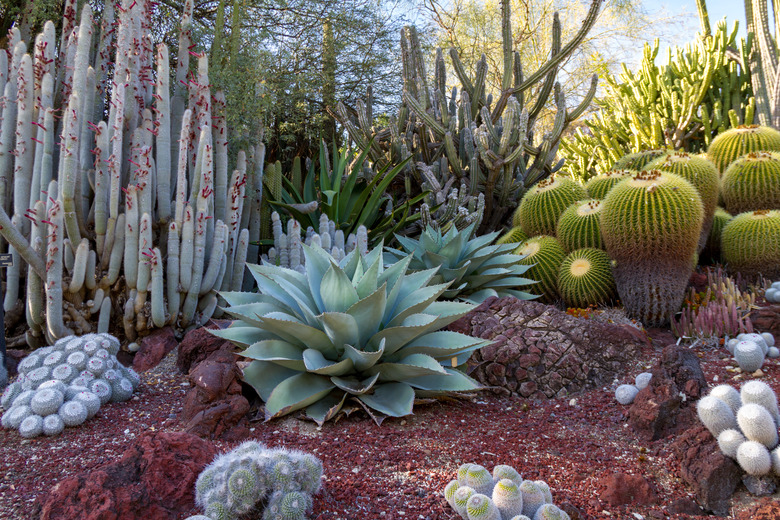How Long Can Plants Live Without Water?
We may receive a commission on purchases made from links.
Plants can't live without water, but how often they need to receive it to stay alive varies tremendously. Factors that influence a plant's water needs include the plant's age, rate of growth, the kind of plant, how well established it is, soil type and whether it's in a container or in the ground. Environmental conditions such as temperature and relative humidity are also important. At one extreme are vulnerable, fast-growing plants like seedlings, which may need water several times a day. At the other end are water-storing succulents that can live for several years without water.
Succulent Plants Survive Drought
Succulent Plants Survive Drought
Succulent plants occur in all hot desert regions of the world except Australia, and they use the strategy of storing water in leaves, stems or roots to survive drought. Succulent plant expert Dr. Park Nobel discusses cactus water needs in his book, "Environmental Biology of Agaves and Cacti." He lists three kinds of opuntia that survived without water for three years. Note that for coastal deserts, recorded rainfall amounts may be misleading. In northern Chile's coastal desert, for example, native cactuses survive six years without rain, but they do get some moisture from periodic fogs. Opuntia spp. is hardy in U.S. Department of Agriculture plant hardiness zones 3b through 11 and some varieties have invasive tendencies.
Native Plants Tolerate Drought
Native Plants Tolerate Drought
In arid regions, native trees and shrubs can survive long periods without rain. They depend on structural modifications such as waxy or hairy leaf coatings and reduced or absent leaves to help prevent plant water loss. Often they have deep roots to find deep soil moisture. Mesquite roots of almost 200 feet long have been recorded. Extended droughts deprive established native plants of water for months at a time.
Phoenix, Arizona, experienced 143 days without rain in 2006; Tucson had 81 rain-free days in 1984. In Texas, Lubbock didn't receive any rain for the entire year of 1956. A take-home lesson from these examples is to use native plants in home landscapes to save water and keep landscapes viable even during drought. Mesquite spp. is hardy in USDA zones 6B through 9B and some varieties have invasive tendencies.
Dormant Plants Need Little Water
Dormant Plants Need Little Water
Dormant plants can often go without water for a long time without using all their stored water and energy to the point of death. One method for overwintering geraniums (Pelargonium x hortorum) in cold winter areas is to dig the plants up and store them in a cool, dark place for the winter months. Geranium is hardy in USDA zones 10 to 11. Likewise, frangipani (Plumeria spp.), hardy in USDA zones 9 through 11, can be bare-rooted and stored all winter in a cool, dry area without water and not be harmed.
Broad-Leaved Plants Need Water
Broad-Leaved Plants Need Water
There's no hard-and-fast rule about how long it takes for broad-leaved plants to die if you don't water them. Much depends on the age of the plant, how fast it's growing and how hot it is. For instance, in summer's heat, fast-growing, large-leaved plants such as squash (Cucurbita pepo) need two to three times more water to not only stay alive, but produce a crop, than they would in cooler weather. Inattention for a day or two could be fatal to your vegetables.
Bear in mind that even well-watered, mature squash plants undergo a mid-day wilt in hot weather. Fast-growing seedlings of any sort, especially in a well-draining soil-less mix, need checking more than once a day as they use up seed reserves and establish a new root system.
References
- University of Florida IFAS Extension: Opuntia spp. Prickly Pear Cactus
- Livescience: Rain in Phoenix Ends Record Dry Spell at 143 Days
- Arizona-Sonora Desert Museum: Frequently Asked Questions About the Desert Museum
- Texas State Library and Archives Commission: "So Would Hell"
- Iowa State University Extension: Horticulture & Home Pest News: How to Overwinter Geraniums
- Texas Tech University: Department of Plant & Soil Science: Geranium
- Floridata: Plumeria Spp.
- University of Florida IFAS Extension: Prosopis Glandulosa: Mesquite
